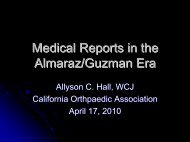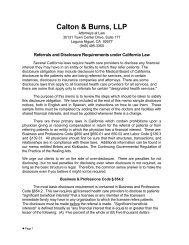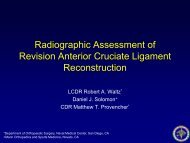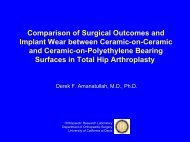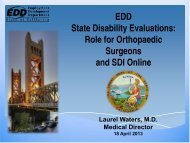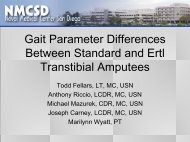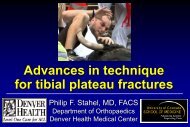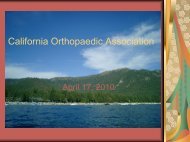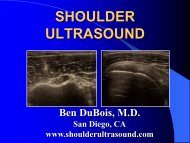Enhancing Your Practice's Revenue - California Orthopaedic ...
Enhancing Your Practice's Revenue - California Orthopaedic ...
Enhancing Your Practice's Revenue - California Orthopaedic ...
- No tags were found...
Create successful ePaper yourself
Turn your PDF publications into a flip-book with our unique Google optimized e-Paper software.
patients, physicians and staff or “you can build it and theymay not come.” Proximity to a hospital for emergencyservices for easy transport of seriously injured patientsshould be taken into account as well. As far as the centeritself is concerned, there are many factors to be considered:1. What services will be provided (e.g., one subspecialtysuch as spine or multiple disciplines)?2. How many physicians will be performing surgery at thesame time?3. Will there be clinical support services on site, such asradiology or therapy?4. What administrative services will be on site (e.g.,scheduling, billing, etc.)?5. Will the facility be owned or leased? Developed fromscratch or placed in an existing facility?6. What amenities are required (parking, restaurantproximity, etc.)?All of these questions need to be addressed during theinitial planning stages or the likelihood is that the physicianswill end up with a facility that does not meet their(or their patients’) needs. If that happens, the facility maynot be used optimally, and this in turn will have an adversefinancial impact.There are many architectural firms in the country thatspecialize in medical office design in general, and ambulatorysurgery centers in particular. The Internet is a usefulsource of information regarding these firms. Another sourceof information is word of mouth. Regardless of which companyis ultimately selected, it is important for physicians tohave input into the final facility design since they will bethe ones using it on a daily basis. Design factors include,but are not limited to, lobby design, patient flow, OR/PACU proximity, ancillary services, and so forth.A quick observation relating to hours that the ASC isopen. Although the center cannot generate income if itis not in use, occupancy costs remain roughly the sameregardless of whether it is open from 9:00 AM to 5:00 PMweekdays or 7:00 AM to 9:00 PM weekdays and Saturdays.This is an argument in favor of longer hours (and that maybe very attractive to patients depending on the nature oftheir surgery). Another argument for keeping the facilityopen for a longer period of time is that it may be possibleto generate income from ancillary services even when nophysician is present.However, longer hours do increase personnel costs (seebelow); furthermore, when staff are asked to work longhours over an extended period of time, they can “burn out”and this can give rise to low morale and high turnover.There is a delicate balance and this must be reflected in thepro forma.Staffing ConsiderationsThe number of support personnel required for the ASCto function efficiently is directly related to the first fourfactors listed in the Physical Facility section (see above).The center will require staff in numerous areas, including:front office/reception, pre-op/PACU/OR, clinical support(patient technicians and orderlies), information technology,insurance and billing, human resources, and management.Since staff salaries represent the highest expense in mostASCs, it is important to not over-staff the center becausethis will have an adverse impact on profitability. However,under-staffing the facility will also have negative consequences,including decreased patient flow, insurance billingback-ups, and potentially a decreased quality of care. Thekey to determining correct staffing levels is to hire a highqualityfacility manager who can make informed decisionregarding, for example, flexible and part-time staffing. Highquality managers command correspondingly high salariesbut they are worth the investment. See # 4 in Ten TopTips, in the Appendix.Regarding ASC staffing, a caution: if physicians own theASC, then employees who work there will be accountableto them. If the center is structured as a joint venture withthe hospital, it could be that JV staff could end up beingleased hospital employees. Their loyalty or level of trainingmay not be all that physician investors might desire.FinancesThere may be many reasons why physicians would investin an ASC, but a primary one is income generation. Asstated above, it is important that investors’ expectationsin this arena are in sync. The first task that needs to beaccomplished is to be sure that they are “speaking the samelanguage” as far as profitability measurement is concerned;that is to say, what formula is to be used in definingprofitability. For more information in this regard, see # 2 inthe “Top Ten Tips” Appendix.To make a profitability calculation using any formula,potential investors must first prepare (or cause to be prepared)a capital budget and a pro forma.• The capital budget delineates the up-front funds thatwill be required in connection with the ASC. Fundswill be required for a myriad of things, includingconsultants (if they are to be used, see above); permits;land acquisition (if a purchase); building construction(if new); building renovation (if existing space will beused); architect fees; equipment; furniture and fixtures;and so forth. The capital budget should be supported byquotes from the companies that will be providing theservices so that the budget is based on reality.• The pro forma is a spreadsheet that sets forth, in asmuch detail as possible, the anticipated revenues and20© 2011 American Academy of <strong>Orthopaedic</strong> Surgeons




